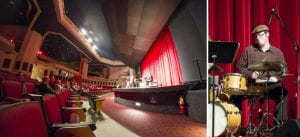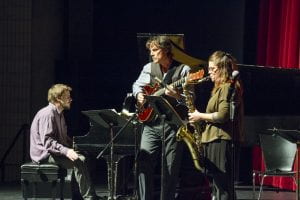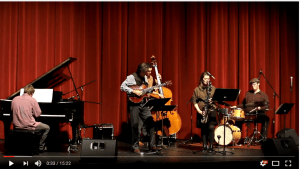Research in Music
Spheres of Influence
By John Dalton
My four years at the University of Massachusetts Dartmouth have been a personal artistic journey–a journey of self-examination, developing not only as a musician but as an innovator and a researcher. Throughout this journey I have constantly asked myself: Who am I as an artist? What should I do to find my own unique, creative voice? These are, of course, never ending questions. But for now I can say that being at UMD’s Music Department has given me a foundation to pursue a career in music that is more than just a performer. It is a career that is combined with research and innovation.
John Dalton’s Spheres of Influence. Click on the image to play the video.
Every senior music student is required to put on a recital to showcase what they have accomplished in their time at the university. As an honors student, I knew I had to aim for something more ambitious. Therefore, I decided to put together a group of not only my peers, but of professional musicians and one of my Professors. The group includes current students (myself and Caitlin Walsh), two alumni (Miles Flisher and Sean Farias), and one of my professors (Jim Robitaille). This is a quintet that consists of saxophone (Caitlin), guitar (Jim), piano (Miles), bass (Sean), and drums (myself). Bringing together this group of people required not only research and coordination, but also financial support. Thanks to a grant from the OUR I successfully executed this complicated project.
§
As a jazz musician one makes the decision to throw themselves into a continuum– the rich and vast legacy of many creative minds who advanced this form of music. I am interested in creating new jazz music and finding my own personal approach to both improvisation and composition. In doing so, I get inspired by many sources of influence. At my core, I am intrigued by the post-bop traditions of the 1960’s, which includes such artists as John Coltrane, Wayne Shorter, Joe Henderson, Herbie Hancock, McCoy Tyner, and Eric Dolphy. I have also begun to draw inspiration from successful contemporary jazz musicians, including Brad Mehldau, Donny McCaslin, and Kneebody. Also, as a jazz drummer, I am inspired by masters of the instrument such as Elvin Jones, Roy Haynes, Jack Dejohnette, Tony Williams, Bob Moses, Paul Motian, Brian Blade, Jorge Rossy, Nate Wood, Mark Guiliana, as well as local drummers Luther Gray and Chris Poudrier. These influences continue to color my approach as I try to reach for something that is uniquely my own expression. To achieve this goal, I have created a group under the moniker of Spheres of Influence.
Spheres of Influence is my own modular ensemble, which aims to perform both my own music and the music that I resonate with. A Sphere of Influence is an international relations term which denotes the region in which one nation holds power or influence. I decided to co-opt this term for my own work as the name allows for the group to be modular. Each group under this moniker represents its own sphere and its own artistic place, thus changing the influences made by other groups. In improvised music the range of individual players in any particular configuration can change the nature of the music. What unifies the concept though is the overall character of the music played by the whole group. The music is always guided by certain aesthetic principles–principles that are universal between different iterations.
My vision for this group was to put on a free public concert in the College of Visual and Performing Arts’s main auditorium, showcasing a program of primarily original jazz compositions. The performance was also recorded and released as a high-quality video (view it above). While this concert was a collaborative effort between many musicians, a great deal of individual work went into it.

Left: Rehearsal at the College of Visual and Performing Arts’s main auditorium; right: Portrait of John Dalton during performance. Photographs courtesy of Dan Waterman.
§
Perhaps the best place to start describing my individual contribution, is the work I put in practicing my instrument. I also practiced particular material for this recital and this ranged from different grooves and time feels to soloing ideas. I had been thinking about the general idea of the recital in my practicing for some time, but there were still many concrete steps that I had to take.
Many of these steps taken have occurred in no particular order (in fact, they were often simultaneous). But I have compiled and listed them here in a fashion that makes sense in a chronological order. The first step I took was figuring out which musicians I wanted to work with. I knew right away that I wanted to have both Miles Fisher and Caitlin Walsh on the program, as they are two of my closest friends and collaborators. I also knew, pretty early on, that I wanted to have my professor and project advisor, Jim Robitaille. Professor Robitaille is a master musician who has worked with many talented musicians, in addition to being an excellent player and composer himself. I wanted to use this opportunity to collaborate and perform with him. Finally, I decided to hire Sean Farias to round out the group because he has an excellent reputation in the Boston area as a musician.
I also put a great deal of effort into writing and arranging some of the pieces. In this concert four of the nine tunes are my own compositions, including two new pieces I had written over the summer. I also had to compile the other pieces for the group, which included three more original compositions (each written by separate members of the group and two covers). During this process, I also thought about how the pieces should be arranged, according to both my tastes and the tastes of my fellow musicians.
After these preliminary stages, I began to figure out the details for booking the space. I decided to use the main auditorium as I felt it would be an appropriate venue for the musicians I had chosen. In this stage I also started to work on assembling promotional materials, which included designing a poster, as well as contacting various promotional outlets (for both inside and outside of the school). During the process, I came across the OUR grant opportunities, and decided to apply. I was lucky enough to be awarded a generous amount that helped support part of the recital and the research that went into the making of this music.
The next item on the agenda was organizing two rehearsals. Due to the busy schedules of the chosen musicians, I booked two rehearsals in October, well in advance. The first rehearsal was an interesting experience; it was my first time directing a group like that. It was especially strange having to give directions to Professor Robitaille and Sean, due to their reputations and stature as musicians. In the second rehearsal I was able to better ascertain my bearings and give more clear instructions. It was a great experience, as I learned to examine the group sound, and make sure that people were playing their parts. It was also interesting to experiment with different ensemble textures, which I felt needed to be worked in, making sure that pieces had a certain flow to them. If this were a more regularly working group, these sorts of textures and dynamics would not need to be said, as they could be formed spontaneously. However, due to time constraints it was the most logical choice.

Spheres of Influence in action. Photograph courtesy of Dan Waterman.
§
The day of the concert was very gratifying. Playing with musicians of this caliber is not only exciting, but also educational. There is also a level of comfort and trust; and this gives an amazing feeling. Indeed, this is part of the beauty of this kind of art form. Jazz is a communal experience, and the relationships one has with other musicians has an impact on one’s own musical style. When there is a deep connection between musicians, it can be felt in the way they play together.
Another interesting facet of this performance was the extent to which the results were different from my own personal expectations. Many of the solos took on different directions than what I had anticipated. I really enjoyed this aspect of the project, as it is those unexpected turns that bring about some of the most powerful moments in improvising. Of course, sometimes these risks don’t pay off, but they have to be done as part of the process. The thrill of improvising when everything comes together makes the process worth the risk of things not working out.
This performance was positively received by both my peers and mentors, which I greatly appreciate. My greatest achievement was that I inspired some of the younger musician peers at the University to work hard and diligently at their craft. Throughout the process of researching and developing this music, I learned that my art can be a positive force for change in the world– whatever that may be: from advocacy to suggestion of a better future, or even making someone’s day a little better. I hope that this concert can also contribute to my future research on the development of improvised music. I look forward to searching for new sounds, while also pay homage to those that came before me. Above all, I hope that my music will continue to build upon the rich foundation that I, and many others here at UMass Dartmouth, draw inspiration from.
§
As far as future plans, I would like to make this a regular, working group. Upon receiving the recordings, I was very pleased with the overall group chemistry, but I believe that this group could become a more cohesive unit. I felt that the performances ran into errors that would not be an issue if we were a group that played more regularly. Because of this, I would like to perform with this iteration of the group whenever the opportunity arises. Additionally, I would like to start making inroads in the Boston jazz scene, performing with as many different musicians as possible– both as a leader and sideman. Overall, I am very happy with how this concert turned out. It was an honor playing with gifted colleagues and mentors, and I hope to do it again in the near future.


